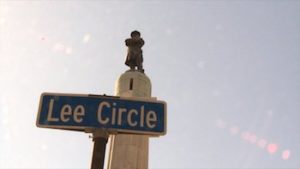
*On this date in 2017, the last of four confederate monuments in New Orleans were removed from public view in the crescent city.
Crews in New Orleans fastened straps around a statue of Confederate General Robert E. Lee as the city worked to remove the last of the four monuments its leaders see as racially offensive. As the blue straps encircled the bronze figure of Lee with crossed arms atop a 60-foot marble column in the center of a busy traffic circle, New Orleans Mayor Mitch Landrieu was half a mile away speaking to an audience that included civil rights leaders, city officials and activists. He told them the statues celebrated "the lost cause of the Confederacy."
Unlike at a removal earlier that month, there were no clashes between supporters and opponents of the statues. Landrieu said the four monuments were out of step with a modern city that embraces people of all races while acknowledging that New Orleans was also once one of the biggest slave markets in America. "We cannot be afraid of the truth," said Landrieu, who, along with other city leaders, decided to take down the monuments in 2015, a decision that withstood challenges in federal court. He called them "symbols of white supremacy" and a part of a movement "to rewrite history, to hide the truth, which is that the Confederacy was on the wrong side of humanity."
Also that day, in Alabama, the legislature sent a bill to the desk of Governor Kay Ivey that would prohibit the removal of monuments on public property that have been in place for at least 20 years. Eileen Jones, a spokeswoman for Ivey, said that Ivey had not decided whether to sign the bill into law. Since May 11, crews in New Orleans have removed monuments to Jefferson Davis, president of the pro-slavery Confederacy, and P.G.T. Beauregard, a Confederate general. In April, a monument was taken down that commemorated an 1874 attack on the racially integrated city police and state militia by a white supremacist group called the Crescent City White League. Landrieu said, "(The monuments) were erected purposefully to send a strong message to all who walked in the shadows (of them) about who was still in charge in this city.”
Earlier that month, dozens of supporters of the monuments clashed with hundreds of demonstrators near the site of the Lee statue. The resistance to their removal was from those who argue the monuments are important symbols of the city's Southern heritage. As General Lee’s statue was removed, there was no significant presence of those who wanted to keep the monuments. More than 100 supporters of the removals were on hand listening to a jazz band, not unlike a city park in New Orleans on any Friday. Landrieu spokeswoman Erin Burns said the city would hold the monuments and consider proposals to move them to the government or non-profit entities. The Lee monument was dedicated in 1884 on the birthday of the first U.S. president, George Washington. The Confederacy was made up of states that attempted to preserve slavery in the South and secede from the United States in the Civil War of 1861 to 1865.
Bernie Woodall, Fort Lauderdale, and Alex Dobuzinskis, Los Angeles.
